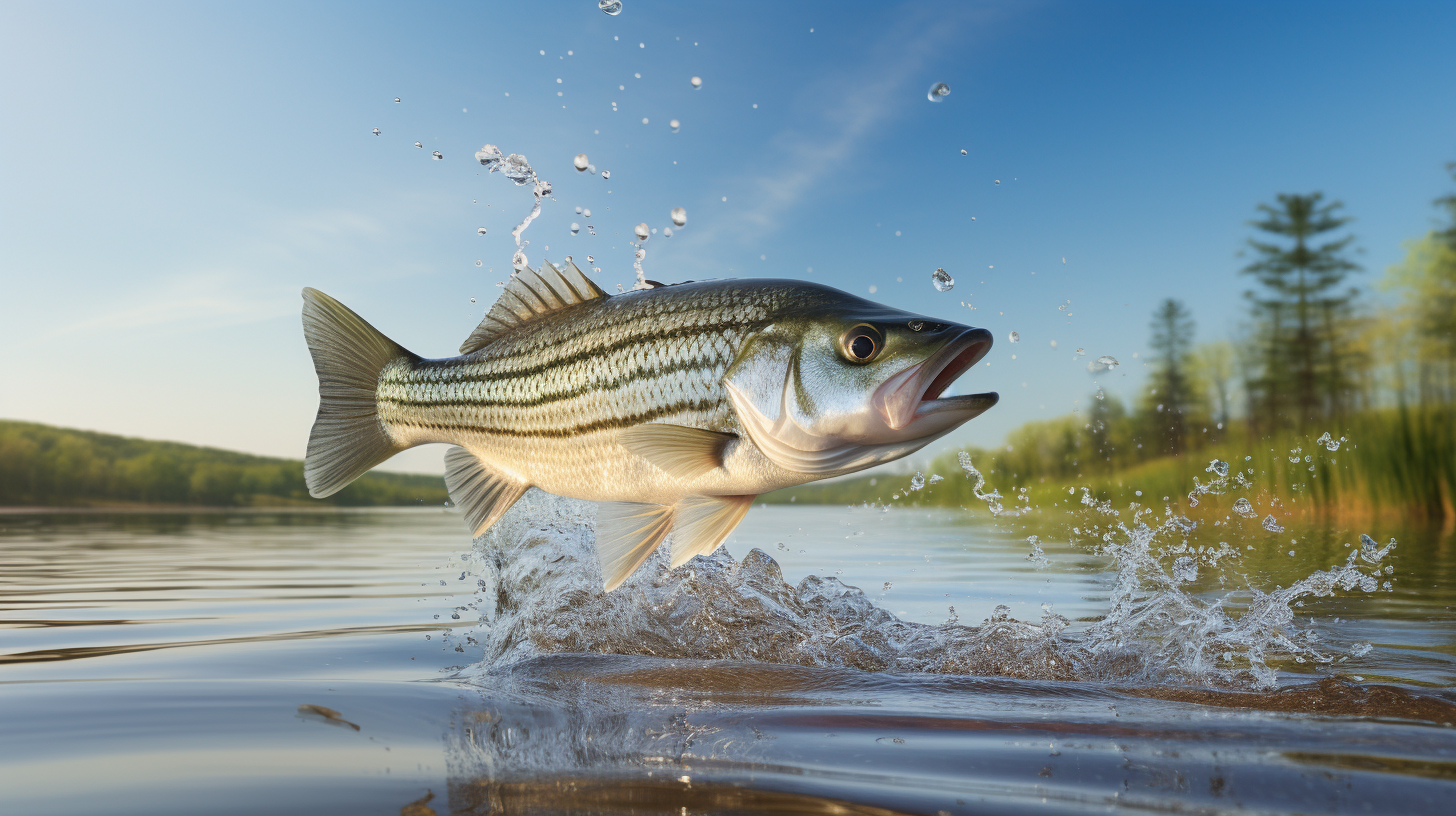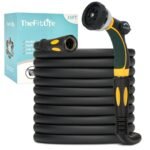Striped bass is a popular game fish that can be found in the Atlantic Ocean, from Florida to Nova Scotia, and in the Gulf of Mexico. It is also known as striper, rockfish, and linesider. The fish is known for its distinctive stripes and can grow up to 5 feet in length and weigh up to 77 pounds.
Striped bass is a prized catch for many anglers due to its size, fighting ability, and delicious taste. It is a versatile fish that can be cooked in a variety of ways, including grilling, sautéing, broiling, pan-searing, and oven-roasting.
In this article, we will explore the habitat, diet, fishing techniques, tackle and gear, regulations, tips and tricks, conservation efforts, and popular destinations for catching striped bass.
Key Takeaways
- Striped bass is a popular game fish found in the Atlantic Ocean and Gulf of Mexico.
- It can grow up to 5 feet in length and weigh up to 77 pounds.
- Striped bass is a versatile fish that can be cooked in a variety of ways.
Habitat: Where to Find This Type of Fish
The Striped Bass, also known as Morone saxatilis, is a predatory fish that is native to the Atlantic coastline of North America. They can be found from the St. Lawrence River into the Gulf of Mexico to Louisiana.
Striped Bass are anadromous fish, which means they migrate between fresh and saltwater. They spawn in freshwater and then move to saltwater to mature. During their lives, they may move back and forth between fresh and saltwater several times.
Read More OutdoorGoodness Articles
Striped Bass prefer water temperatures between 60°F and 75°F. They are often found in deep, clear impoundments with water temperatures in the mid-70°F’s/21°C+. They are also found in rivers, estuaries, and bays.
Striped Bass are powerful fish and enjoy the surf. They are not very swift nor graceful. At times, you can see them swirl conspicuously at the surface or splash in pursuit of baitfish. They are known to be attracted to structure, such as rocks, jetties, and piers.
In conclusion, Striped Bass can be found in a variety of habitats along the Atlantic coastline of North America. They prefer water temperatures between 60°F and 75°F and are often found in deep, clear impoundments with water temperatures in the mid-70°F’s/21°C+. They are also found in rivers, estuaries, and bays.
Diet: The Secret to Catching This Fish Type
Knowing what striped bass eat can be the key to catching them. Striped bass are opportunistic feeders, and their diet changes depending on the season and location. Here are some common foods that striped bass consume:
- Baitfish: Striped bass love to eat small baitfish such as herring, anchovies, and silversides. These fish are often found in schools and can be easily caught with a cast net.
- Crustaceans: Crabs, lobsters, and shrimp are also on the striped bass menu. These crustaceans can be found in rocky areas and along the shoreline.
- Squid: Squid is a favorite food of striped bass, especially during the summer months. Squid can be caught with a jig or a squid jig.
- Eels: Eels are a popular bait for striped bass fishing. Striped bass love to eat eels and will often strike them aggressively.
- Other Fish: Striped bass are known to eat a variety of other fish, including flounder, sea robins, and sculpins.
It’s important to note that striped bass are not always picky eaters. They will also eat artificial lures such as plugs, jigs, and soft plastics. However, using live bait that mimics their natural diet can increase your chances of catching them.
In conclusion, understanding the striped bass diet can be the key to catching them. By using bait that mimics their natural diet, you can increase your chances of success.
So, the next time you’re out fishing for striped bass, make sure to bring along some baitfish, crustaceans, squid, eels, or other fish that they commonly eat.
Fishing Techniques: Mastering the Art of Catching This Fish Type
Striped Bass is a popular game fish that can be caught using a variety of fishing techniques. Here are some of the most effective ways to catch this elusive fish:
Trolling
Trolling is a popular technique for catching Striped Bass. It involves dragging lures or baits behind a moving boat. This method is effective because it allows you to cover a lot of water quickly. Use lures that imitate baitfish, such as spoons, plugs, or soft plastic baits. Vary your trolling speed and depth until you find the right combination that triggers strikes.
Casting
Casting is another effective technique for catching Striped Bass. This method involves casting lures or baits towards structure, such as rocks, jetties, or submerged logs. Use lures that imitate baitfish, such as swimbaits, jigs, or topwater plugs. Vary your retrieve speed and depth until you find the right combination that triggers strikes.
Jigging
Jigging is a technique that involves using a weighted lure that is bounced off the bottom. This method is effective because it allows you to target Striped Bass that are holding close to the bottom. Use jigs that imitate baitfish, such as bucktail jigs, soft plastic jigs, or metal jigs. Vary your jigging speed and depth until you find the right combination that triggers strikes.
Live Bait Fishing
Live bait fishing is a technique that involves using live baitfish, such as mackerel, herring, or squid, to entice Striped Bass to bite. This method is effective because it mimics the natural prey of Striped Bass. Use a variety of rigs, such as a fish finder rig or a Carolina rig, to present your live bait in a natural manner. Vary your bait size and location until you find the right combination that triggers strikes.
In conclusion, mastering the art of catching Striped Bass requires knowledge of the most effective fishing techniques. Whether you prefer trolling, casting, jigging, or live bait fishing, use the right lures or baits, vary your presentation, and experiment until you find the right combination that triggers strikes.
Tackle and Gear: Essential Equipment for This Fish Type
When it comes to catching striped bass, having the right tackle and gear is essential. Here are some of the must-have equipment you should consider:
Rod and Reel
The rod and reel combo you choose will depend on your personal preference and the fishing technique you plan to use. For example, if you plan to fish from a boat, a medium-heavy rod with a fast action paired with a spinning reel is a good choice. On the other hand, if you plan to fish from shore, a longer rod with a slower action and a baitcasting reel may be better suited for the job.
Line
The fishing line you choose should be strong enough to handle the weight of the fish you’re targeting, but not so heavy that it affects the action of your lure. Monofilament line is a popular choice for striped bass fishing, but braided line is also a good option, especially if you’re fishing in heavy cover.
Lures
There are many different types of lures that work well for striped bass, including topwater plugs, swimbaits, jigs, and soft plastics. It’s a good idea to have a variety of lures in your tackle box so you can switch things up if the fish aren’t biting.
Terminal Tackle
Terminal tackle refers to the hooks, swivels, and other small pieces of equipment you use to rig your lures. For striped bass fishing, circle hooks are a popular choice because they are less likely to cause injury to the fish and are easier to remove. You’ll also want to have a variety of sinkers and weights on hand to help you get your lure down to the desired depth.
Other Essentials
In addition to the above equipment, there are a few other items you’ll want to have on hand when fishing for striped bass. These include:
- Polarized sunglasses to help you see fish and structure below the water’s surface
- A landing net to help you safely land and release the fish
- Pliers or a hook remover to help you safely remove hooks from the fish’s mouth
- Sunscreen and a hat to protect you from the sun’s harmful rays
Overall, having the right tackle and gear is crucial for a successful day of striped bass fishing. With the right equipment and a little bit of know-how, you’ll be well on your way to reeling in these hard-fighting fish.
Regulations: Stay Legal and Fish Responsibly
When it comes to fishing for Striped Bass, it is important to follow the regulations set forth by the local government and wildlife agencies. Not only is it the law, but it is also crucial for the conservation and sustainability of the species. Here are some guidelines to follow to ensure that you are fishing legally and responsibly:
- Check the regulations: Be sure to check the local regulations before you head out to fish for Striped Bass. These regulations can vary depending on the location, time of year, and size limits. For example, the Atlantic States Marine Fisheries Commission (ASMFC) has recently approved emergency measures to lower the upper end of the striped bass slot size to 31 inches. Be aware of these changes and stay up to date.
- Obtain the necessary permits: In addition to following the regulations, make sure you have the necessary permits and licenses. This includes a fishing license and any specific permits required for Striped Bass fishing. These permits are usually available for purchase online or at local bait and tackle shops.
- Practice catch and release: Striped Bass are a popular game fish, but it is important to practice catch and release to help ensure their sustainability. If you do decide to keep a fish, make sure it is within the legal size limit and follow proper handling techniques to minimize harm to the fish.
- Use responsible fishing gear: Using responsible fishing gear can help minimize harm to the fish and the environment. Avoid using lead sinkers, which can be harmful to wildlife if ingested. Instead, opt for non-toxic alternatives. Additionally, make sure your fishing gear is in good condition and properly maintained.
By following these guidelines, you can enjoy fishing for Striped Bass while also helping to preserve the species for future generations. Remember, it is up to all of us to fish responsibly and protect our natural resources.
Tips and Tricks: Expert Tips for Catching More of This Fish Type
If you’re looking to catch more striped bass, there are a few expert tips that can help you improve your chances. Here are some tips to keep in mind:
- Use a fish-finder: Having a boat equipped with a reliable fish-finder can help you locate a productive area in which striped bass have gathered. Having a firm understanding of how to operate your fish-finder will aid you in locating a productive area in which striped bass have gathered.
- Locate rip currents: One of the best places to find striped bass is in/around rip currents, where bait collects. Look for areas where the water is moving quickly and the surface is choppy.
- Vary your bait: Striped bass can be picky eaters, so it’s important to vary your bait until you find what works. Some popular options include live eels, clams, and bunker chunks.
- Fish at the right time: Striped bass are most active during low light conditions, such as early morning or late evening. Try to plan your fishing trips around these times for the best results.
- Experiment with lures: If you’re not having luck with live bait, try experimenting with lures. Some popular options include topwater plugs, jigs, and soft plastics.
- Consider the weather: Striped bass are more active in certain weather conditions. For example, they tend to be more active on cloudy days than on sunny days. Keep an eye on the weather forecast and plan your fishing trips accordingly.
By following these expert tips, you can increase your chances of catching more striped bass. Remember to be patient and persistent, and don’t be afraid to try new techniques until you find what works.
Conservation: Protecting This Fish Type
Striped bass is a popular fish species that is enjoyed by recreational and commercial fishermen alike. However, overfishing and environmental factors have led to a decline in the population of striped bass. As a result, it is important to take measures to conserve this fish type.
Bycatch Regulations
Bycatch Regulations are in place to minimize bycatch. Bycatch refers to the unintentional capture of non-target species, such as juvenile striped bass. To reduce bycatch, fishermen can use specific gear, such as circle hooks or fish traps, that are less likely to catch non-target species.
Stock Assessment
According to the 2018 stock assessment, Atlantic striped bass are overfished and subject to overfishing. As a result, it is important to monitor the population of striped bass and adjust fishing regulations accordingly. The Atlantic States Marine Fisheries Commission (ASMFC) oversees the management of striped bass and provides guidance on fishing regulations.
Fishing for Conservation
Recreational fishermen can also take steps to conserve striped bass. For example, when catching striped bass, it is important to handle the fish carefully to avoid injuring it. Ideally, you should keep the fish in the water while de-hooking. If you do bring the fish into the boat, never use a rag or towel to hold the fish. This will rub the protective slime layer and scales off the fish, making it more susceptible to disease. Striped bass can be held by the lower jaw (“lipped”) or cradled from underneath the belly.
Conclusion
Conservation efforts are crucial to protecting the population of striped bass. By following regulations and handling fish carefully, we can help ensure that future generations can enjoy this popular fish species.
Safety: Stay Safe While Reeling in the Big One
Fishing for Striped Bass can be an exciting and rewarding experience, but it’s important to prioritize safety while out on the water. Here are some tips to help you stay safe while reeling in the big one:
Wear a Life Jacket
One of the most important safety measures you can take while fishing for Striped Bass is to wear a life jacket. Accidents can happen, and a life jacket can help keep you afloat and breathing if you fall into the water.
Use Proper Equipment
Make sure you have the right equipment for the job. Use a sturdy fishing rod and reel that can handle the weight of a Striped Bass, and use a hook that is appropriate for the size of the fish you are targeting. Using the wrong equipment can be dangerous and can even harm the fish.
Be Aware of Your Surroundings
Before casting your line, take a moment to look around and assess your surroundings. Make sure there are no obstacles or other boats in the area that could cause a collision. Also, be aware of the weather conditions and any changes that may occur while you are out on the water.
Practice Catch and Release
Striped Bass are a valuable resource, and it’s important to practice catch and release to help maintain healthy populations. When releasing a fish, handle it gently and quickly to minimize stress. If you must keep a fish, make sure it is of legal size and follow all local regulations.
Stay Hydrated and Protected from the Sun
Fishing can be a long and tiring activity, so make sure to stay hydrated and protected from the sun. Wear sunscreen and a hat to protect your skin, and bring plenty of water to drink throughout the day.
By following these safety tips, you can enjoy a fun and successful day of fishing for Striped Bass while staying safe on the water.
Record Catches: Breaking Records: The Biggest Fish of This Type Ever Caught
Striped bass are a popular game fish that have been caught in various parts of the world. Over the years, many anglers have tried their luck at catching the biggest striped bass ever recorded. Here are some of the most notable record catches of this species:
- Gregory Myerson holds the record for the largest striped bass ever caught. His 81-pound, 14-ounce striped bass was caught near Long Island Sound in 2011. Myerson was fishing a live eel when he hooked into the world record striper, measuring in at 54 inches. (source: Salt Water Sportsman)
- Rob Lindholm set the state record for the largest striped bass ever reeled in by an angler in New Hampshire on June 26, 1980. The striper tipped the scales at a whopping 60 lbs and was 54 inches long. (source: WMUR)
- In Arkansas, Jeff Fletcher caught the state record for striped bass in 2000. His catch weighed 64 pounds, 8 ounces, and was caught at Beaver Lake Tailwater. (source: Outdoor Life)
These record catches are a testament to the popularity and thrill of catching striped bass. Anglers from all over the world continue to try their luck at catching the biggest fish of this type ever recorded.
Popular Destinations: Where to Go for the Ultimate Fishing Experience for This Fish Type
Striped Bass is a popular game fish known for its strong fight and delicious taste. If you’re looking for the ultimate fishing experience for this fish type, here are some popular destinations to consider:
| Destination | Location | Best Time to Fish | Notes |
|---|---|---|---|
| Cape Cod | Massachusetts, USA | May – October | Known for its large striped bass population and scenic coastline. |
| Chesapeake Bay | Maryland & Virginia, USA | April – June & September – November | One of the largest estuaries in the world, home to a variety of fish species including striped bass. |
| Montauk | New York, USA | May – October | Known as the “Striped Bass Capital of the World” with a variety of fishing options including surfcasting and charter boats. |
| Outer Banks | North Carolina, USA | May – October | A popular vacation spot with a variety of fishing options including surfcasting and inshore charters. |
| San Francisco Bay | California, USA | April – November | Known for its large striped bass population and scenic views of the Golden Gate Bridge. |
These destinations offer a variety of fishing options including surfcasting, inshore charters, and more. It’s important to note that fishing regulations vary by location and season, so be sure to check local regulations before you go.
In addition to these popular destinations, there are many other locations around the world where you can catch striped bass. With its strong fight and delicious taste, striped bass is a sought-after game fish that can provide an exciting and rewarding fishing experience.
History and Culture: The Legacy of Fishing This Fish Type
Striped Bass, also known as “rockfish,” have a rich history and cultural significance in the United States. Native Americans and early settlers relied on the fish for sustenance and trade. In fact, the Massachusetts Bay colony banned the use of Striped Bass as fertilizer in 1639 to encourage the development of fishery commerce with Europe.
Today, Striped Bass fishing is a popular recreational activity along the Atlantic coast and in California. The fish has also become an important commercial catch, with the majority of the catch coming from the Chesapeake Bay.
However, the popularity of Striped Bass fishing has led to concerns about overfishing and the impact on the fish population. In response, regulations have been put in place to protect the species and ensure sustainable fishing practices.
Despite these concerns, Striped Bass remains an important part of American culture and cuisine. The fish is often featured in traditional dishes such as Maryland-style crab cakes and New England clam chowder.
Overall, Striped Bass has a legacy that spans centuries and continues to play an important role in both fishing and American culture.
Future Outlook: The Future of Fishing This Fish Type
The future of striped bass fishing depends on proper management practices and conservation efforts. Overfishing, habitat loss, and climate change are the biggest threats facing this species. However, with the right measures in place, the future looks promising.
Conservation Efforts
Conservation efforts are essential to protect the striped bass population. The Atlantic States Marine Fisheries Commission (ASMFC) manages the fishery and sets regulations for recreational and commercial fishing. These regulations include catch limits, size limits, and closed seasons. By following these regulations, anglers can help ensure the sustainability of the striped bass population.
Habitat Restoration
Habitat loss is a major threat to the striped bass population. Restoration efforts, such as the removal of dams and the restoration of wetlands, can help improve the health of the species’ habitat. These efforts can also benefit other species that rely on the same habitat.
Climate Change
Climate change is a significant threat to the striped bass population. Rising sea temperatures and changing ocean currents can impact the species’ distribution and migration patterns. Additionally, extreme weather events, such as hurricanes, can damage critical habitat. By reducing carbon emissions and taking steps to mitigate the effects of climate change, we can help protect the future of striped bass fishing.
In conclusion, the future of striped bass fishing depends on our collective efforts to protect the species and its habitat. By following regulations, supporting conservation efforts, and taking steps to mitigate the effects of climate change, we can ensure that future generations can enjoy this iconic fish.
Key Takeaways for This Fish Type
Striped Bass is a popular game fish that can be found in both freshwater and saltwater environments. Here are some key takeaways to keep in mind when fishing for Striped Bass:
- Match the Hatch: When choosing lures, try to match the size, color, and shape of the baitfish that the Striped Bass are feeding on. This can increase your chances of getting a bite.
- Use the Right Line: For freshwater Striped Bass fishing, monofilament lines with a pound test of 10-20 are a good choice for smaller fish, while larger fish may require a braided line with a pound test of 30-50. Color can vary depending on the water clarity and light conditions, with green or clear being popular choices. Specific lines such as Berkley Trilene can also be effective.
- Target the Right Areas: Inlets, back bays, and other areas with water temperatures between 55 and 65 degrees Fahrenheit are ideal for Striped Bass. Look for areas with structure such as rocks, drop-offs, and weed beds where the fish can hide and ambush their prey.
- Gear Up Right: A 9wt fly rod is recommended for Striped Bass fishing, although a 7/8wt can work for smaller fish. Use sinking lines to get your fly down to the fish, and choose flies that imitate the baitfish in the area.
- Be Patient: Striped Bass can be finicky and may not bite right away. Be patient and try different lures, techniques, and areas until you find what works.
By keeping these key takeaways in mind, you can increase your chances of success when fishing for Striped Bass. Remember to always follow local regulations and practice catch-and-release to help preserve this valuable game fish for future generations.
Conclusion
In conclusion, Striped Bass is a popular fish species that can be found in the Atlantic Ocean. It is a prized catch among anglers due to its delicious taste and large size. Striped Bass can grow up to 5 feet in length and weigh up to 77 pounds, making it a challenging fish to catch.
One interesting fact about Striped Bass is that they have a fairly long lifespan, up to 30 years. The growth rate of Striped Bass depends on where they live, and males are sexually mature between the ages of 2 and 4 years old. Females, on the other hand, are able to reproduce when they are 4 to 8 years old and produce large quantities of eggs, which are fertilized by the males.
It is important to note that Striped Bass populations have declined in recent years due to overfishing and habitat destruction. As such, it is crucial to practice responsible fishing and conservation efforts to ensure the sustainability of this species.
Overall, Striped Bass is a fascinating fish species that is worth learning more about. Whether you are an angler or simply interested in marine life, Striped Bass is a species that is sure to captivate your attention.
Frequently Asked Questions
Is it safe to eat striped bass?
Yes, it is safe to eat striped bass. However, it is important to follow local advisories and guidelines regarding the consumption of fish caught in certain areas. Striped bass can accumulate contaminants, such as mercury, in their flesh. It is recommended that pregnant women, nursing mothers, and young children limit their consumption of striped bass.
What is the best time of day to catch striped bass?
The best time of day to catch striped bass is typically during low light conditions, such as dawn or dusk. Striped bass are known to feed more actively during these times. However, they can also be caught during the day, especially if the water is cloudy or choppy.
How long do striped bass live?
Striped bass can live up to 30 years in the wild, but their lifespan can be shorter in areas with high fishing pressure or poor water quality.
What is the average size of a striped bass?
The average size of a striped bass can vary depending on location and other factors. In general, adult striped bass can range from 20 to 40 inches in length and weigh between 5 and 30 pounds. However, larger specimens can grow up to 6 feet in length and weigh over 100 pounds.
What is the best bait for catching striped bass?
The best bait for catching striped bass can vary depending on the location and time of year. Some popular baits include live eels, bunker, clams, and sandworms. Artificial lures, such as jigs, plugs, and soft plastics, can also be effective.
Can striped bass be found in freshwater?
Yes, striped bass can be found in freshwater. They are anadromous fish, meaning they spend most of their lives in saltwater but migrate to freshwater to spawn. In some areas, striped bass have been introduced to freshwater lakes and rivers for recreational fishing purposes.

Meet Kevin Goodell, your outdoor adventure coach! With a passion for nature ignited in childhood, Kevin brings a wealth of experience and expertise to simplify tough outdoor skills. As a U.S. Army veteran and former Sergeant, he has honed his leadership and teamwork abilities while developing a deep love for the great outdoors.
Kevin’s dedication to outdoor activities spans biking, birdwatching, national park trips, and archery/golf. With his friendly and approachable demeanor, he is committed to guiding individuals of all ages and skill levels towards unforgettable outdoor experiences.
Harnessing his extensive knowledge and personal achievements, Kevin is your go-to resource for learning and enjoying various outdoor pursuits. Whether you seek thrilling adventures or serene nature escapes, Kevin’s professional yet friendly approach will ensure an engaging and informative experience. Embark on your next outdoor adventure with Kevin Goodell and embrace the beauty of nature like never before.






